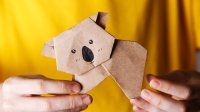Using Origami to Teach Children About Endangered Animals
As elementary students turn squares of paper into animals they’re studying, the age-old Japanese art form makes lessons more memorable.
Your content has been saved!
Go to My Saved Content.Origami, the Japanese art of folding paper, has been around for thousands of years. In its infancy, these creased creations ranged from practical to purely whimsical. In the 21st century, its uses have expanded, especially in classroom settings. It can be used to help children understand physics, geometry, and even simple fractions.
This past year, our school used this paper art form to help students learn more about endangered and threatened animals. Understanding more about endangered animals is helpful to encourage environmental stewardship, empathy, and awareness. Our hope was that it might even be the catalyst to get students involved in doing more to help these wonderful creatures.
Origami allows students to think, interpret, and engage with the learning material, all things that are important when it comes to retaining information. Clear memories of a lesson paired with positive, novel, or visual content can create strong ties to what is being taught. There is a small window of time to take something from our short-term memory and place it in our long-term memory. Manipulating paper to create origami is one way to prevent knowledge memory loss.
Getting Started With Origami
Setting up an origami lesson such as this takes practice and preparation. Here are some tips to help you succeed on your folding journey.
First, you will need paper. If your time or budget allows, you may consider buying precut squares of origami paper. You can buy packs of up to 500 sheets for an affordable price. Six- to 8-inch squares should suffice. Another option is to cut the paper yourself. Regular printer paper works fairly well if you are going this route. Stay away from paper that is too soft or too rigid, such as tissue paper or construction paper, as they have a tendency to rip or not hold their shape, and they can be difficult to fold. You could also have students cut their own squares using printer paper. Simply fold one corner of the paper to an opposite side until it forms a triangle, and cut off the bottom. You can use this diagram to help.
Next, in preparation for the lesson, familiarize yourself with some different origami models by folding them. If planning a more direct-instruction style lesson where you will teach kids how to fold the model, you will want to practice many times until folding that animal becomes second nature to you. Always remember to choose models that are skill-level and developmentally appropriate. Most origami books, websites, and videos rank models using a system such as easy, medium, or hard. Determine which is best for you and your students.
Consider scaffolding the lesson by starting off with a simple animal and working your way up. For example, a third-grade class may start off with a dog face, then fold a simple butterfly, and end with a traditional swan. Some chosen threatened animals for these models could be the African wild dog, Karner blue butterfly, and trumpeter swan.
Incorporating Inquiry-Based Learning
Another way to structure the lesson is through inquiry-driven work. First, have students research an endangered animal of their choice. The International Union for Conservation of Nature’s Red List of Threatened Species has a wealth of information and pictures of threatened animal species. Once their animal is selected, students can find origami websites, videos, or books to show how to fold their chosen origami animal.
Resources such as the school library; YouTube, which has many step-by-step videos; and websites like origami-fun and the art for kids hub can all be accessed by students in person or online. Give your learners plenty of time to practice until they get it right. Be encouraging and offer support when needed.
A Place-Based Option
One final option is to use local animals that are listed as threatened or endangered for the lesson. This presents a more place-based educational approach that can get kids thinking about their own community. Increasing their awareness may motivate them to make changes where they live. The U.S. Fish and Wildlife Service has an excellent database and search engine tool that can help students look up plants and animals of various vulnerability levels by state.
No matter which way you choose to structure the lesson—direct instruction, or inquiry- or place-based learning—it is always fun to let kids decorate their origami models. Encourage them to add details like those on their animal. Depending on their age, they may even want to play and interact with their origami. Decorating or playing with their pieces can help increase their enjoyment for the media, as well as strengthen the learning connections being made.
